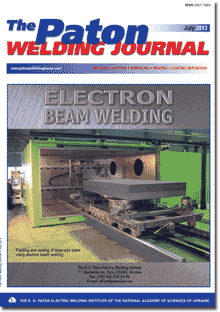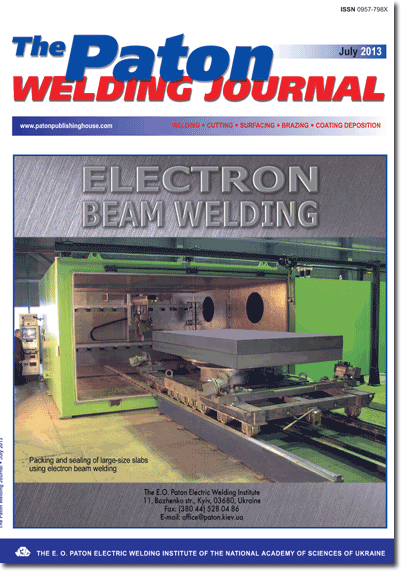| 2013 №07 (05) | 2013 №07 (07) |

The Paton Welding Journal, 2013, #7, 39-43 pages
ACQUISITION OF PROCESS IRREGULARITIES BY MEANS OF ACOUSTIC DISTORTION PARAMETERS DURING GMA WELDING PROCESSES
U. REISGEN and J. de VRIES
RWTH Aachen, Welding and Joining Institute. 49 Pontstrasse, 52062, Aachen, Germany. E-mail: office@isf.rwth-aachen.de
Abstract
In GMAW, process irregularities often result in weld defects and have, thus, negative effect on the weld quality. Currently, the online detection of these irregularities in industrial production is mainly based on the analysis of current path and voltage time curves. Arc length control, which, for example, is used in modern welding machines, evaluats the relative changes of electric process parameters (welding current and voltage) for detection of variations of the arc length. Superimposing interferences are, however, complicating the unambiguous acquisition of arc length via electric parameters. Within the scope of research project, which has been carried out in the Welding and Joining Institute, this problem has been solved by establishing the unambiguous link between length of the arc and acoustic distortion parameters, which are the result of using an arc as a sound converter. For the detection of process irregularities, defined modulation of welding current has been carried out, the changes of which during welding have been acquired and analysed. Similar as in real audio loudspeaker, distortions during reproduction are developing, which are acquired by a directional microphone and subsequently evaluated. The parameters THD (Total Harmony Distortion) and SINAD (Signal-to-Interference Ratio including Noise and Distortion) have turned out to be the most reliable electro-acoustic parameters. Changes of arc geometry exert unambiguous and reproducible effects on these parameters. Vice versa, it is proceeded from the assumption that, in the case of persistence of parameters within a certain corridor, the arc has not been deformed. For the acquisition of arc length, the modulation of arc and acoustic acquisition and evaluation offer thus an unambiguous alternative and/or completion to the method, which has been used so far and is based on the electric parameters. The measuring set-up and test results of this novel measuring method will be specified in detail in this paper. 10 Ref., 6 Figures.
Keywords: GMA welding, quality control, acoustic emission, arc length control, audisignal distortion parameters, power sources
Received: 15.06.13
Published: 28.07.13
References
1. Platz, J. (1986) Beitrag zur Verbesserung eines lichtbogengesteuerten Schweisskopffuhrungssystems: Diss. Aachen: RWTH.
2. Duan, Y., Jin, H. (1999) Digital controller design for switchmode power converters. In: 14th APEC Proc., Vol.2, 967-973.
3. Nowak, S., Jaeschke, B. (2002) Moderne Konzepte digitaler Schweissmaschinen, Fachtagung Elektrische Energiewandlungssysteme. Magdeburg: Otto-von-Guericke-Universitat.
4. Jaeschke, B. (2003) Digital gesteuerte Stromquellen fur das Lichtbogenschweissen: Diss. Magdeburg: Otto-von-Guericke-Universitat.
5. Tessmar, V., Koppe, K. (2007) Die Vielfalt des MSG-Verfahrens gewinnbringend nutzen: Blech Inform 1. Munchen: Carl Hanser Verlag.
6. Matthes, K.-J., Richter, E. (2002) Schweissen von metallischen Konstruktionswerkstoffen. Fachbuchverlag Leipzig im Carl Hanser Verlag.
7. Dilthey, U. (2006) Schweisstechnische Fertigungsverfahren I. Springer.
8. URL. http://www.lansche-audio.de/eng/start. html. Abgerufen am 26.06.2013.
9. Weinzierl, S. (2008) Handbuch der Audiotechnik. Springer.
10. Kestler, W. (2009) Understand SINAD, ENOB, SNR, THD, THD + N, and SFDR. In: Analog Devices Proceedings MT-003.
Suggested Citation
U. REISGEN and J. de VRIES (2013) ACQUISITION OF PROCESS IRREGULARITIES BY MEANS OF ACOUSTIC DISTORTION PARAMETERS DURING GMA WELDING PROCESSES. The Paton Welding J., 07, 39-43.The cost of subscription/purchase order journals or individual articles
| Journal/Currency | Annual Set | 1 issue printed |
1 issue |
one article |
| TPWJ/USD | 384 $ | 32 $ | 26 $ | 13 $ |
| TPWJ/EUR | 348 € | 29 € | 24 € | 12 € |
| TPWJ/UAH | 7200 UAH | 600 UAH | 600 UAH | 280 UAH |
| AS/UAH | 1800 UAH | 300 UAH | 300 UAH | 150 UAH |
| AS/USD | 192 $ | 32 $ | 26 $ | 13 $ |
| AS/EUR | 180 € | 30 € | 25 € | 12 € |
| SEM/UAH | 1200 UAH | 300 UAH | 300 UAH | 150 UAH |
| SEM/USD | 128 $ | 32 $ | 26 $ | 13 $ |
| SEM/EUR | 120 € | 30 € | 25 € | 12 € |
| TDNK/UAH | 1200 UAH | 300 UAH | 300 UAH | 150 UAH |
| TDNK/USD | 128 $ | 32 $ | 26 $ | 13 $ |
| TDNK/EUR | 120 € | 30 € | 25 € | 15 € |
AS = «Automatic Welding» - 6 issues per year;
TPWJ = «PATON WELDING JOURNAL» - 12 issues per year;
SEM = «Electrometallurgy Today» - 4 issues per year;
TDNK = «Technical Diagnostics and Non-Destructive Testing» - 4 issues per year.


